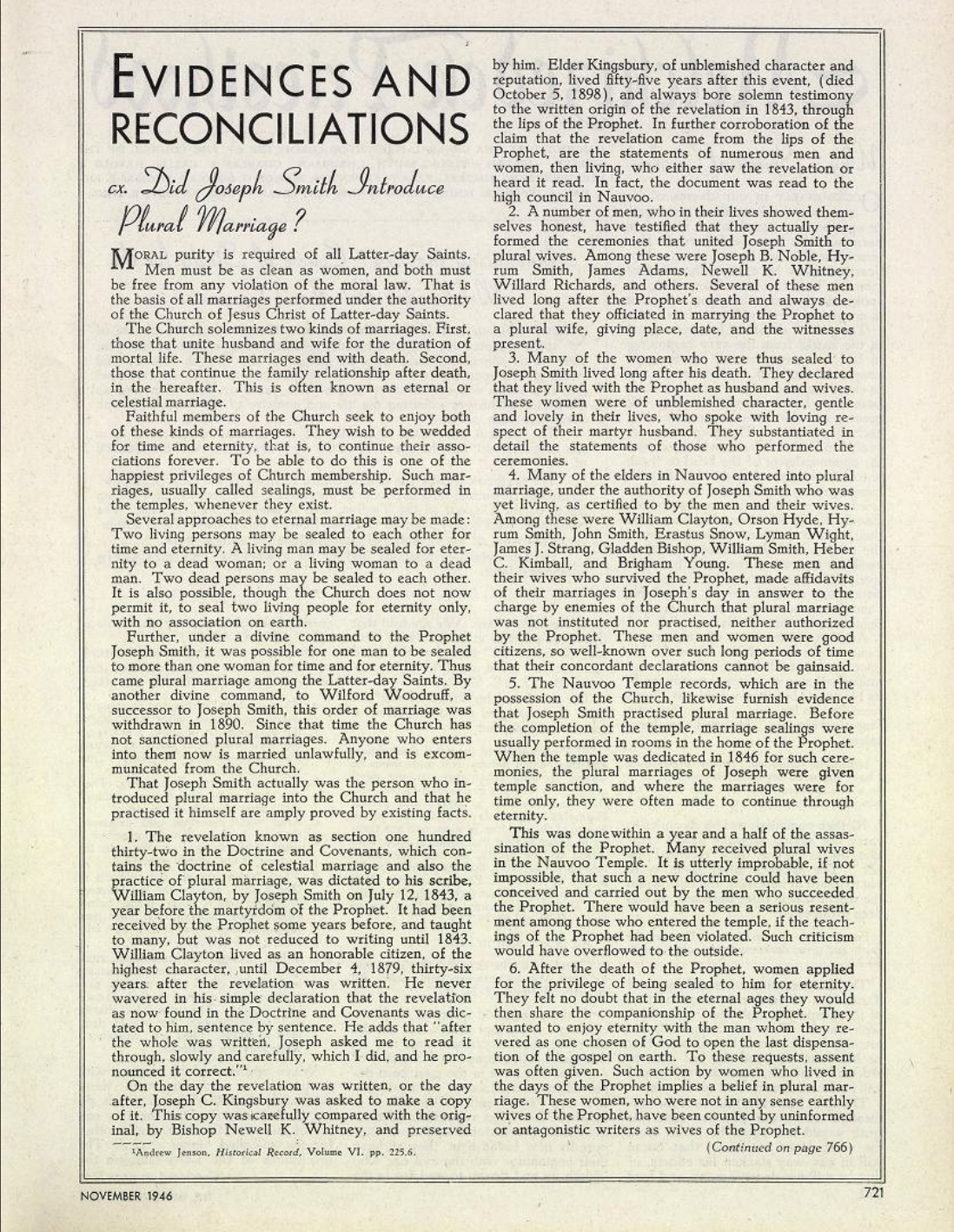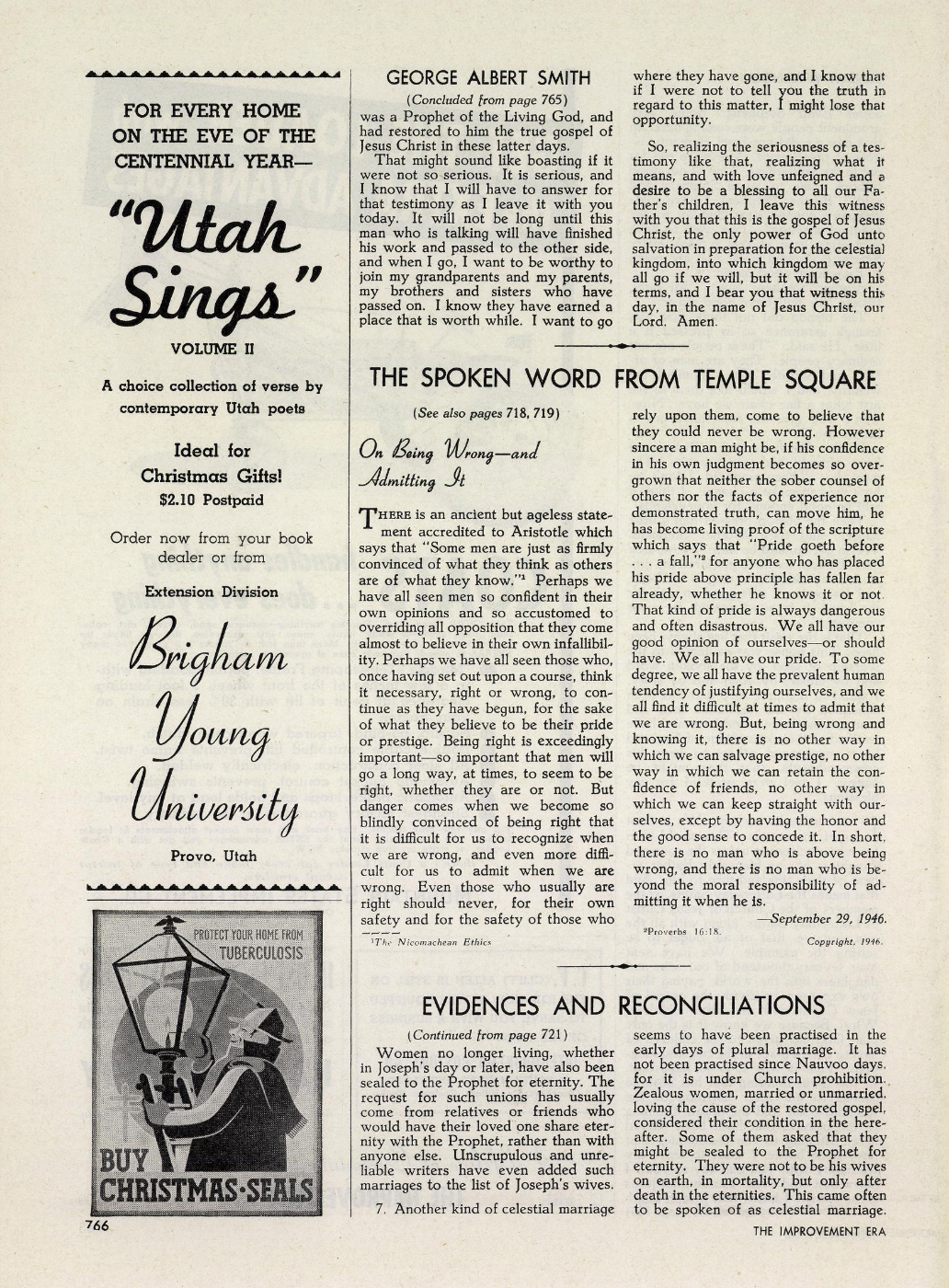John A. Widstoe writes on Joseph introducing plural marriage.
- Type
- Periodical
- Hearsay
- Direct
- Reference
John A. Widtsoe, "Evidences and Reconciliations: cx. Did Joseph Smith Introduce Plural Marriage?" Improvement Era 49, no. 11 (November 1946): 721, 766
- Scribe/Publisher
- Improvement Era
- Audience
- Reading Public
- Transcription
Moral purity is required of all Latter-day Saints. Men must be as clean as women, and both must be free from any violation of the moral law. That is the basis of all marriages performed under the authority of the Church of Jesus Christ of Latter-day Saints.
The Church solemnizes two kinds of marriages. First, those that unite husband and wife for the duration of mortal life. These marriages end with death. Second, those that continue the family relationship after death, in the hereafter. This is often known as eternal or celestial marriage.
Faithful members of the Church seek to enjoy both of these kinds of marriages. They wish to be wedded for time and eternity, that is, to continue their associations forever. To be able to do this is one of the happiest privileges of Church membership. Such marriages, usually called sealings, must be performed in the temples, whenever they exist.
Several approaches to eternal marriage may be made: Two living persons may be sealed to each other for time and eternity. A living man may be sealed for eternity to a dead woman; or a living woman to a dead man. Two dead persons may be sealed to each other. It is also possible, though the Church does not now permit it, to seal two living people for eternity only, with no association on earth.
Further, under a divine command to the Prophet Joseph Smith, it was possible for one man to be sealed to more than one woman for time and for eternity. Thus came plural marriage among the Latter-day Saints. By another divine command, to Wilford Woodruff, a successor to Joseph Smith, this order of marriage was withdrawn in 1890. Since that time the Church has not sanctioned plural marriages. Anyone who enters into them now is married unlawfully, and is excommunicated from the Church.
That Joseph Smith actually was the person who in- troduced plural marriage into the Church and that he practised it himself are amply proved by existing facts.
1. The revelation known as section one hundred thirty-two in the Doctrine and Covenants, which contains the doctrine of celestial marriage and also the practice of plural marriage, was dictated to his scribe, William Clayton, by Joseph Smith on July 12, 1843, a year before the martyrdom of the Prophet. It had been received by the Prophet some years before, and taught to many, but was not reduced to writing until 1843. William Clayton lived as an honorable citizen, of the highest character, until December 4, 1879, thirty-six years after the revelation was written. He never wavered in his simple declaration that the revelation as now found in the Doctrine and Covenants was dictated to him, sentence by sentence. He adds that "after the whole was written, Joseph asked me to read it through, slowly and carefully, which I did, and he pro- nounced it correct."
On the day the revelation was written, or the day after, Joseph C. Kingsbury was asked to make a copy of it. This copy was carefully compared with the orig- inal, by Bishop Newell K. Whitney, and preserved by him. Elder Kingsbury, of unblemished character and reputation, lived fifty-five years after this event, (died October 5, 1898), and always bore solemn testimony to the written origin of the revelation in 1843, through the lips of the Prophet. In further corroboration of the claim that the revelation came from the lips of the Prophet, are the statements of numerous men and women, then living, who either saw the revelation or heard it read. In fact, the document was read to the high council in Nauvoo.
2. A number of men, who in their lives showed them-selves honest, have testified that they actually performed the ceremonies that united Joseph Smith to plural wives. Among these were Joseph B. Noble, Hyrum Smith, James Adams, Newell K. Whitney, Willard Richards, and others. Several of these men lived long after the Prophet's death and always declared that they officiated in marrying the Prophet to a plural wife, giving place, date, and the witnesses present.
3. Many of the women who were thus sealed to Joseph Smith lived long after his death. They declared that they lived with the Prophet as husband and wives. These women were of unblemished character, gentle and lovely in their lives, who spoke with loving respect of their martyr husband. They substantiated in detail the statements of those who performed the ceremonies.
4. Many of the elders in Nauvoo entered into plural marriage, under the authority of Joseph Smith who was yet living, as certified to by the men and their wives. Among these were William Clayton, Orson Hyde, Hyrum Smith, John Smith, Erastus Snow, Lyman Wight, James J. Strang, Gladden Bishop, William Smith, Heber C. Kimball, and Brigham Young. These men and their wives who survived the Prophet, made affidavits of their marriages in Joseph's day in answer to the charge by enemies of the Church that plural marriage was not instituted nor practised, neither authorized by the Prophet. These men and women were good citizens, so well-known over such long periods of time that their concordant declarations cannot be gainsaid.
5. The Nauvoo Temple records, which are in the possession of the Church, likewise furnish evidence that Joseph Smith practised plural marriage. Before the completion of the temple, marriage sealings were usually performed in rooms in the home of the Prophet. When the temple was dedicated in 1846 for such ceremonies, the plural marriages of Joseph were given temple sanction, and where the marriages were for time only, they were often made to continue through eternity.
This was done within a year and a half of the assas- sination of the Prophet. Many received plural wives in the Nauvoo Temple. It is utterly improbable, if not impossible, that such a new doctrine could have been conceived and carried out by the men who succeeded the Prophet. There would have been a serious resentment among those who entered the temple, if the teachings of the Prophet had been violated. Such criticism would have overflowed to the outside.
6. After the death of the Prophet, women applied for the privilege of being sealed to him for eternity. They felt no doubt that in the eternal ages they would then share the companionship of the Prophet. They wanted to enjoy eternity with the man whom they revered as one chosen of God to open the last dispensation of the gospel on earth. To these requests, assent was often given. Such action by women who lived in the days of the Prophet implies a belief in plural marriage. These women, who were not in any sense earthly wives of the Prophet, have been counted by uninformed or antagonistic writers as wives of the Prophet.
Women no longer living, whether in Joseph's day or later, have also been sealed to the Prophet for eternity. The request for such unions has usually come from relatives or friends who would have their loved one share eternity with the Prophet, rather than with anyone else. Unscrupulous and unreliable writers have even added such marriages to the list of Joseph's wives.
7. Another kind of celestial marriage seems to have been practised in the early days of plural marriage. It has not been practised since Nauvoo days, for it is under Church prohibition. Zealous women, married or unmarried, loving the cause of the restored gospel, considered their condition in the here- after. Some of them asked that they might be sealed to the Prophet for eternity. They were not to be his wives on earth, in mortality, but only after death in the eternities. This came often to be spoken of as celestial marriage.
- Citations in Mormonr Qnas
The B. H. Roberts Foundation is not owned by, operated by, or affiliated with the Church of Jesus Christ of Latter-day Saints.


